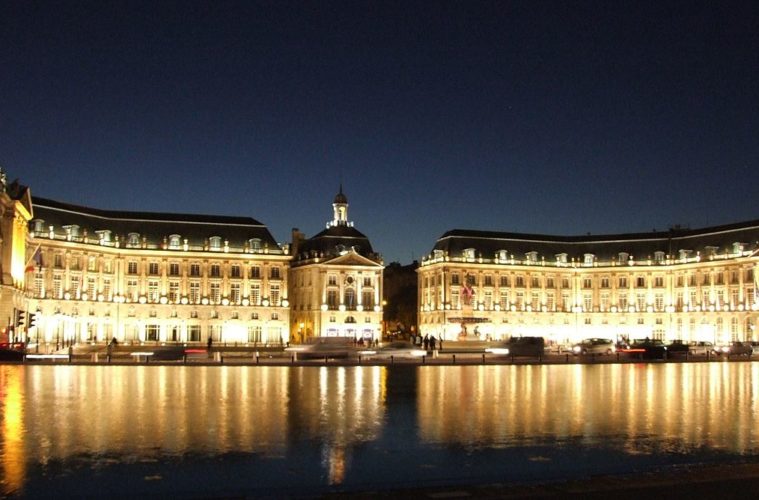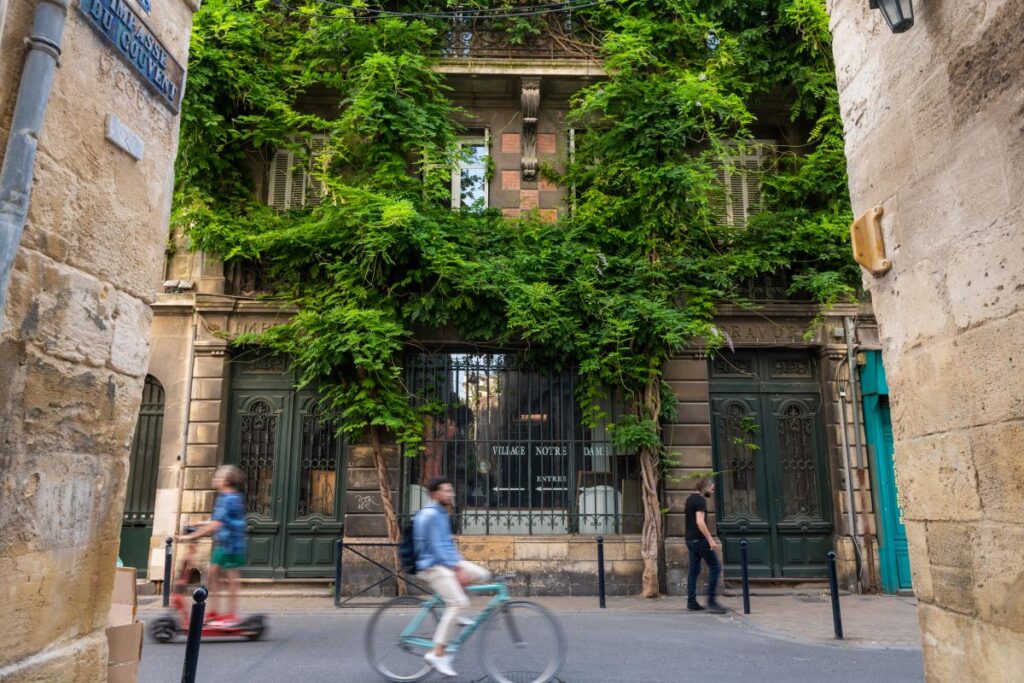
Bordeaux is a glorious city. The gracious and elegant capital of the Aquitaine region is rich with classical buildings, formal squares, tucked-away quartiers where you can wander the streets and find individual shops and boulangeries, cafés and bars, and some unusual and stunning attractions. The city stands proudly on the grand Garonne river on the French Atlantic coast.
Victor Hugo was an admirer: ‘Take Versailles, add Antwerp and you have Bordeaux…Add to that, my friend, the magnificent Gironde, bustling with ships, the delightful backdrop of green hills, a fine sky and warm sun, and you will fall in love with Bordeaux, even if you only drink water.’
I recently spent three days in Bordeaux and despite a punishing schedule missed out quite a few of the city’s attractions. Next time I’ll take a week.
Start with this guide to Bordeaux to make the most of your time here.
Bordeaux – A City Devoted to Wine and the Cité du Vin
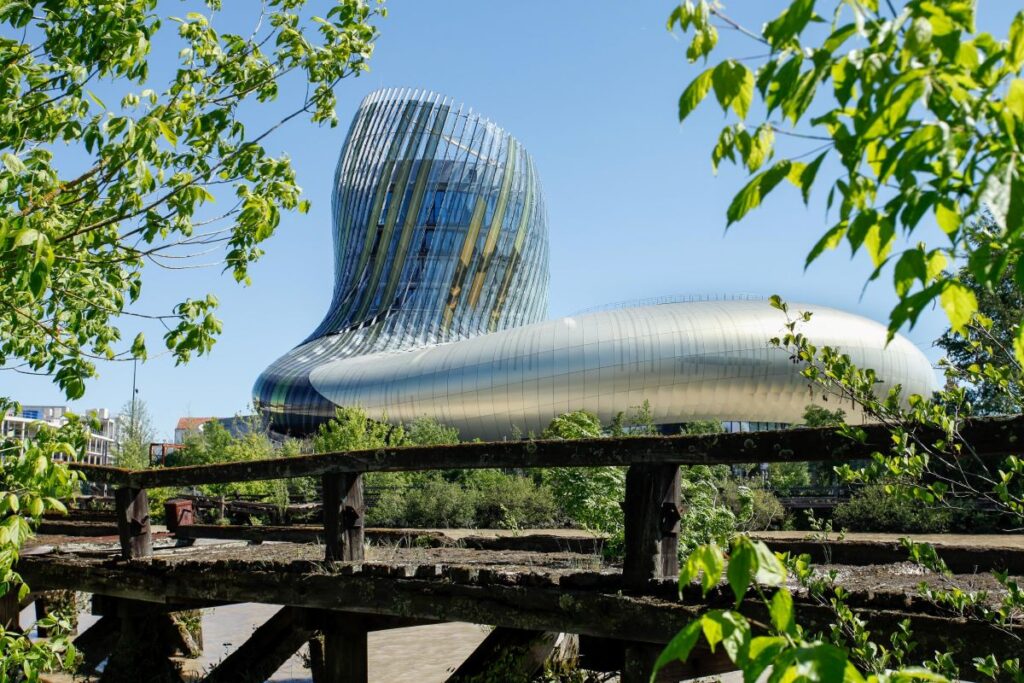
Bordeaux sits at the heart of one of the world’s great wine-producing regions. Anyone with even a passing interest in the noble grape should schedule a visit to the Cité du Vin.
“It’s going to be my Guggenheim” declared Alain Juppé, mayor of Bordeaux in 2006 when the project was born. It’s a pretty extraordinary piece of architecture: its undulating shape and its distinctive curves have been described as evoking a sailing ship…wine poured from a decanter…or swirling around a wine glass.
Make of the outside what you will; inside you’ll find a fascinating series of exhibitions telling you the story of mankind’s great drink. I’d advise at least half a day for a visit, and if you can, eat here at Le 7, restaurant that looks out over the Garonne and Bordeaux.
Don’t Miss: The Bordeaux Wine Festival, normally takes place in June. But next year it coincides with the Tall Ships Race. The race starts in Bordeaux and runs from July 7-11, 2027, the same dates as the Bordeaux Wine Festival.
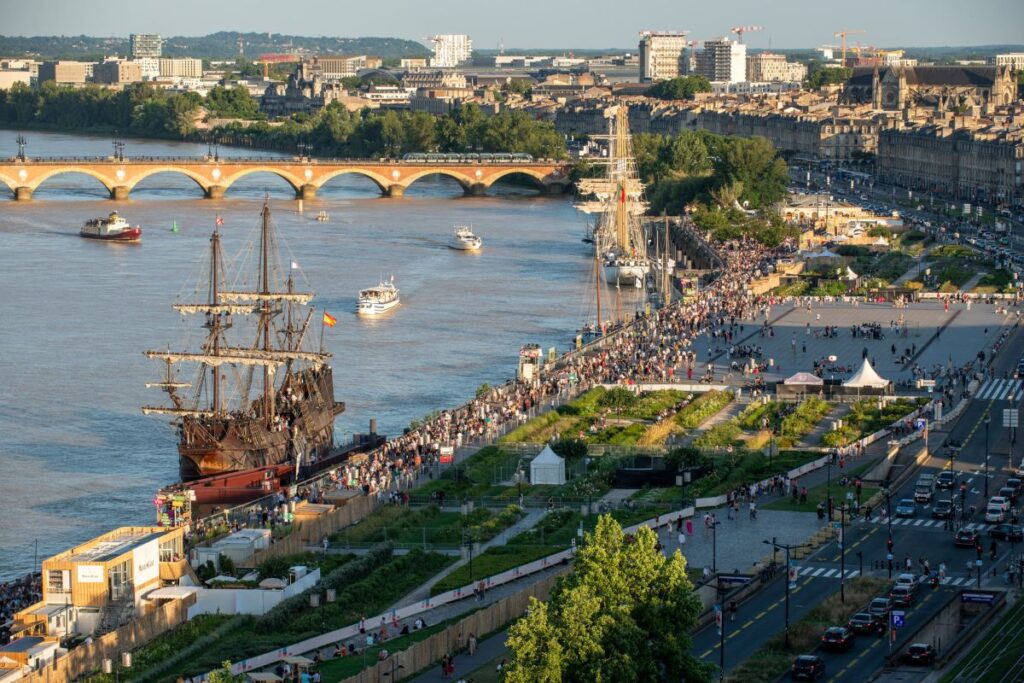
Les Bassins de Lumière
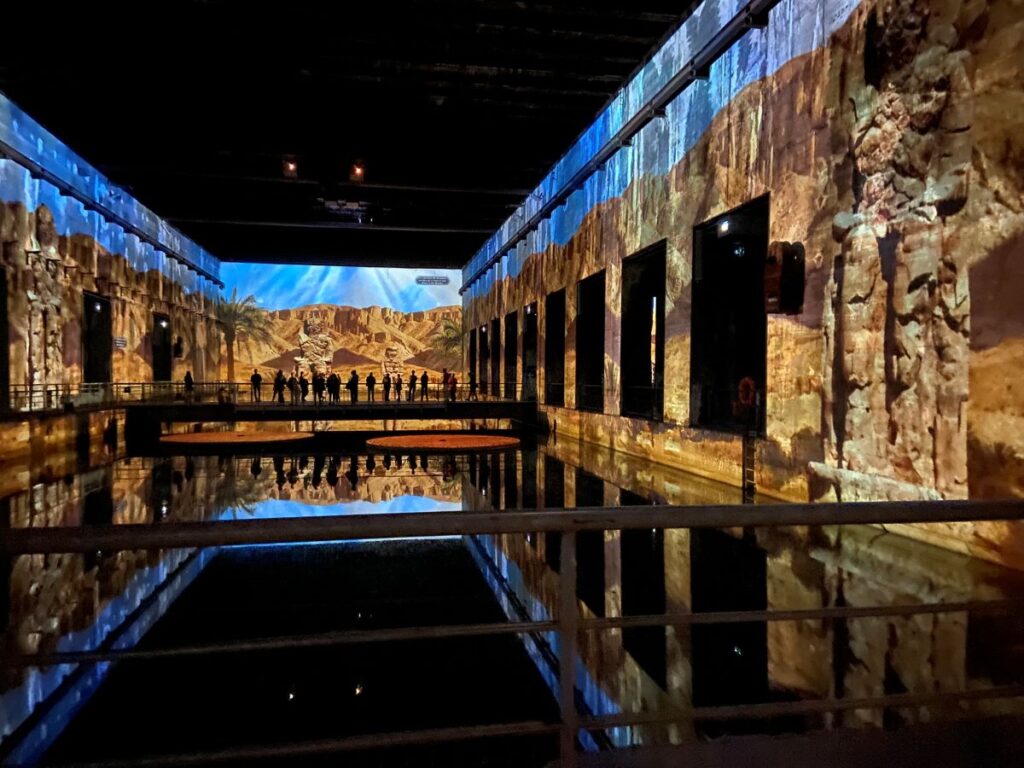
Step inside Les Bassins de Lumière in the same quartier as the Cité du Vin (and conveniently near) for extraordinary annual changing exhibitions. This is the world’s largest digital art centre, offering an experience which will entrance, sometimes frighten, and always impress.
Housed in the former World War II German submarine base in Bacalan, the sound-proofed insulated spaces, some up to 8m high, are filled with 360° images that slowly change. I stood mesmerised in the first gallery, then walked over footbridges into more galleries with different dream-like images.
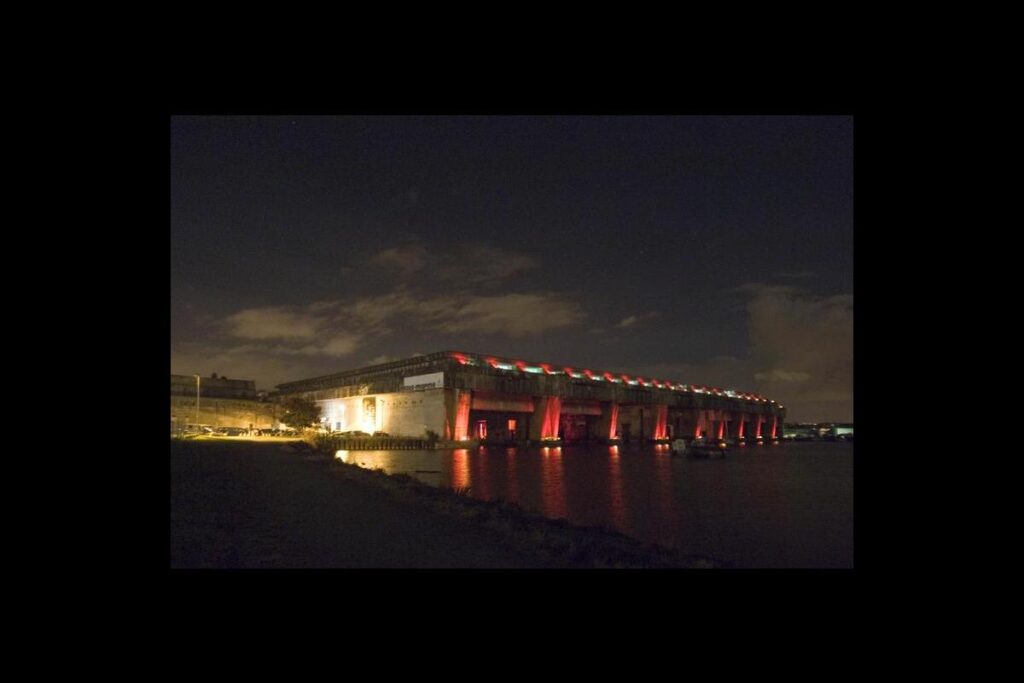
There are six spaces in total, all very varied. Take in the art shows and a huge mooring bay built over the water. As you look, the gates appear to open and submarines seem to enter the base, moving towards you at a menacing speed. There’s an area where you can sit in tiered stages to watch the show from different heights, and a museum space with the history of the building. And of course, a very good shop at the end.
I was there for the 2025 exhibition (which runs to Jan 6, 2026). Egyptian Pharaohs from the Old Kingdom of Khéops to the New Kingdom of Ramsès II (c. 2589 BC to 1213 BC) taught me more about this ancient history than any book I have read. We were brought more up to date with The Orientalists exhibition which focuses on the French Orientalist painters: Ingres, Delacroix and Jean-Léon Gérôme. We were there during the week; on Sundays the place must have been full of families watching The Little Prince come to life with Saint-Exupery’s images blown up to fantastic proportions.
Les Bassins de Lumière website
Tip: If you’re here in the Bacalan district, try shopping at Les Halles de Bacalan for regional and local foods and products. It’s a great place to put together a picnic, or eat a casual lunch at one of the stalls. Open daily except Mondays.
Walk the City’s Old Quartiers
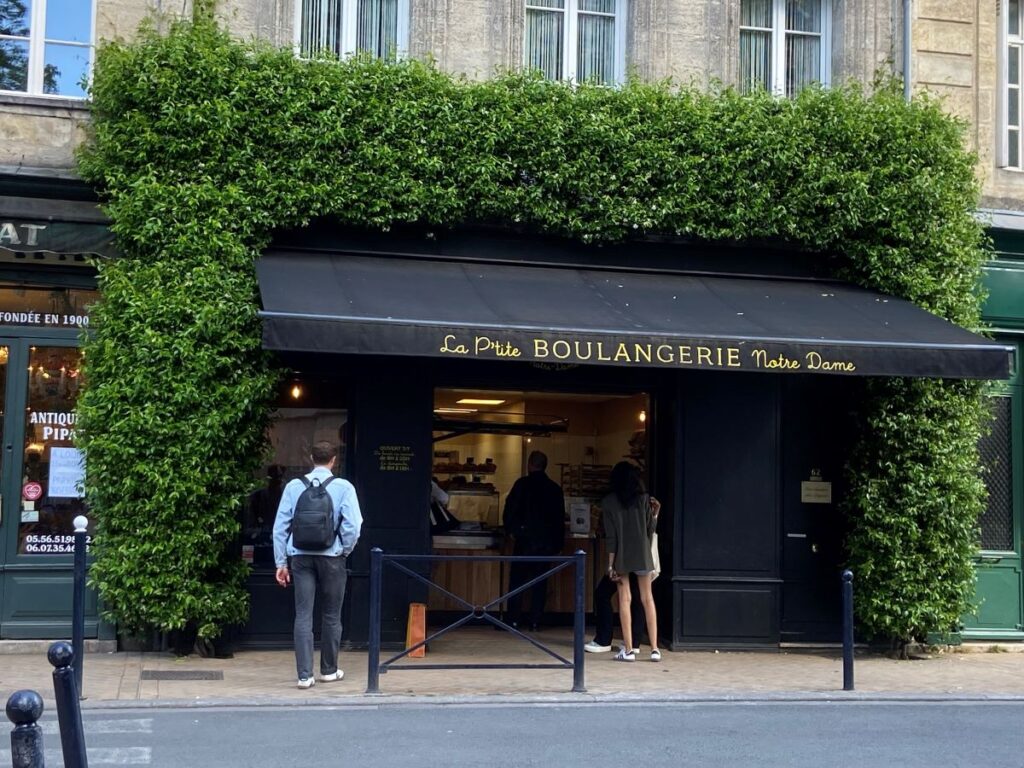
Bordeaux is a great city for walking, particularly through its small compact historic areas. If you have time, pick one and spend a minimum of a couple of hours exploring. If time is limited, take a guided tour. Bruno Coiffard, a Bordeaux guide, took us around different areas, taking great pleasure in pointing out the superiority of Bordeaux over Paris. Bruno Coiffard (+33 6 08 28 65 26). At the end of our two tours we agreed with him (sorry Paris!).
Tip: If you’re feeling peckish as you walk around, pop into one of the Cassonade Cannelés & Spécialités cafés for a coffee and a speciality of the city, a cassonade – a delicious caramelized cake that comes in a distinctive shape.
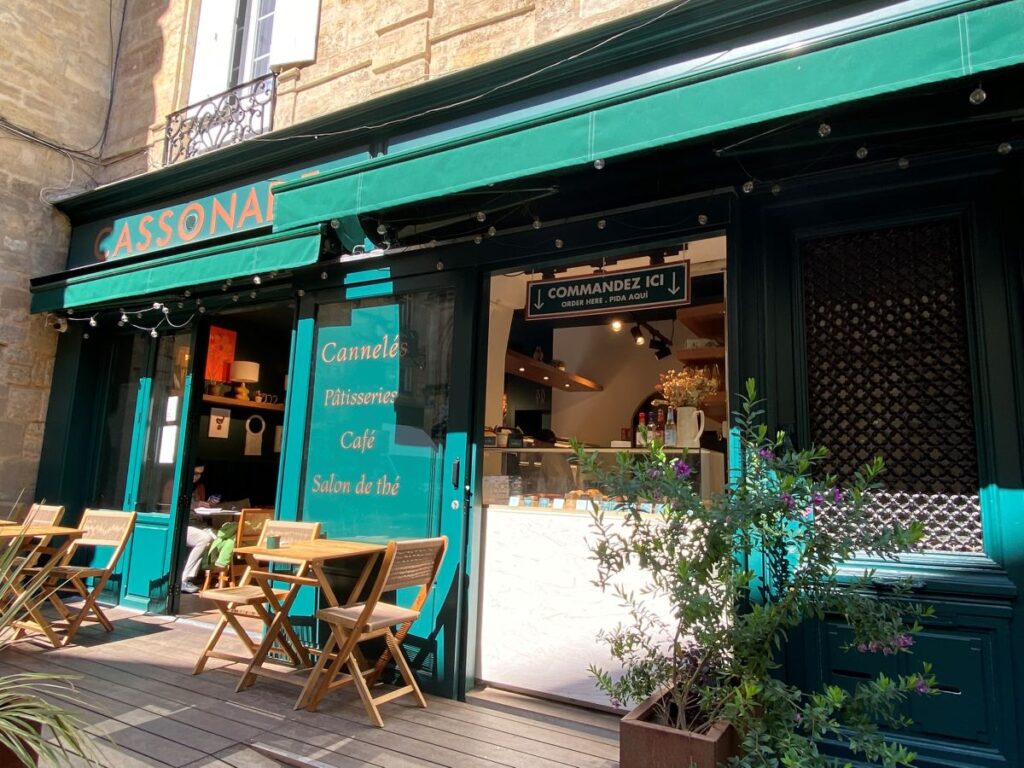
Port de la Lune (Port of the Moon)
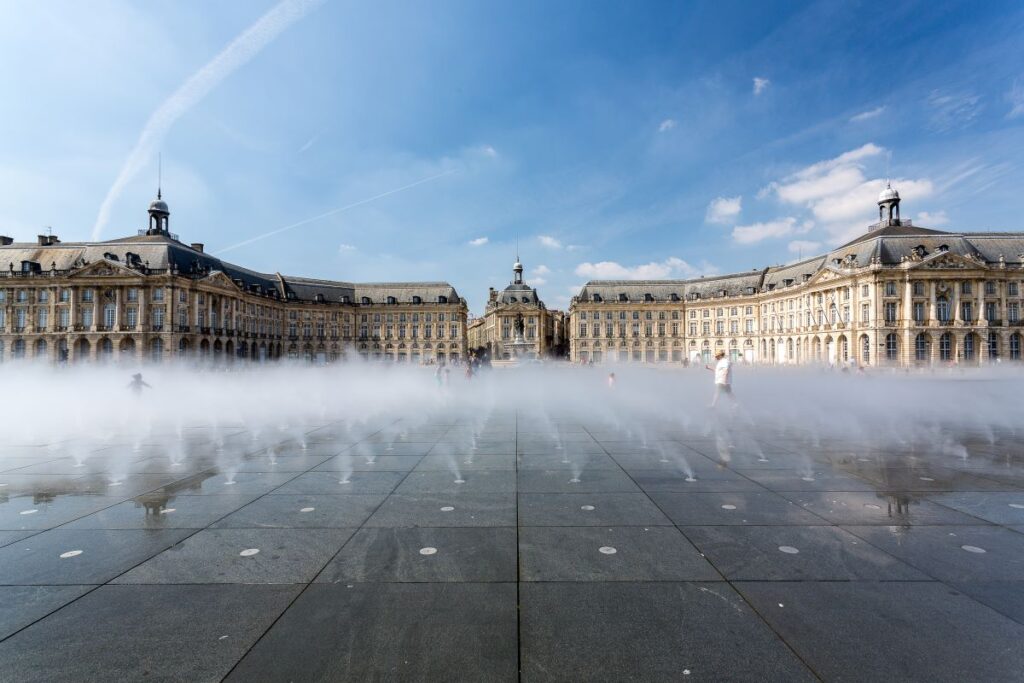
This romantically named quayside doesn’t denote a district as such, but is the heart of old Bordeaux. It’s a crescent-shaped bend in the river, originally the source of Bordeaux’s wealth. In the Saint-Pierre, Saint-Paul district, the Port of the Moon was the heart of the global trading center between Africa, Europe and the Americas.
From the noisy, crowded and dangerous quays, ships carried the precious commodities of coffee, cocoa, cotton, sugar and indigo from to the rest of Europe. By the 18th century, with its dominance as a wine-exporter, Bordeaux was the second busiest port in the world after London.
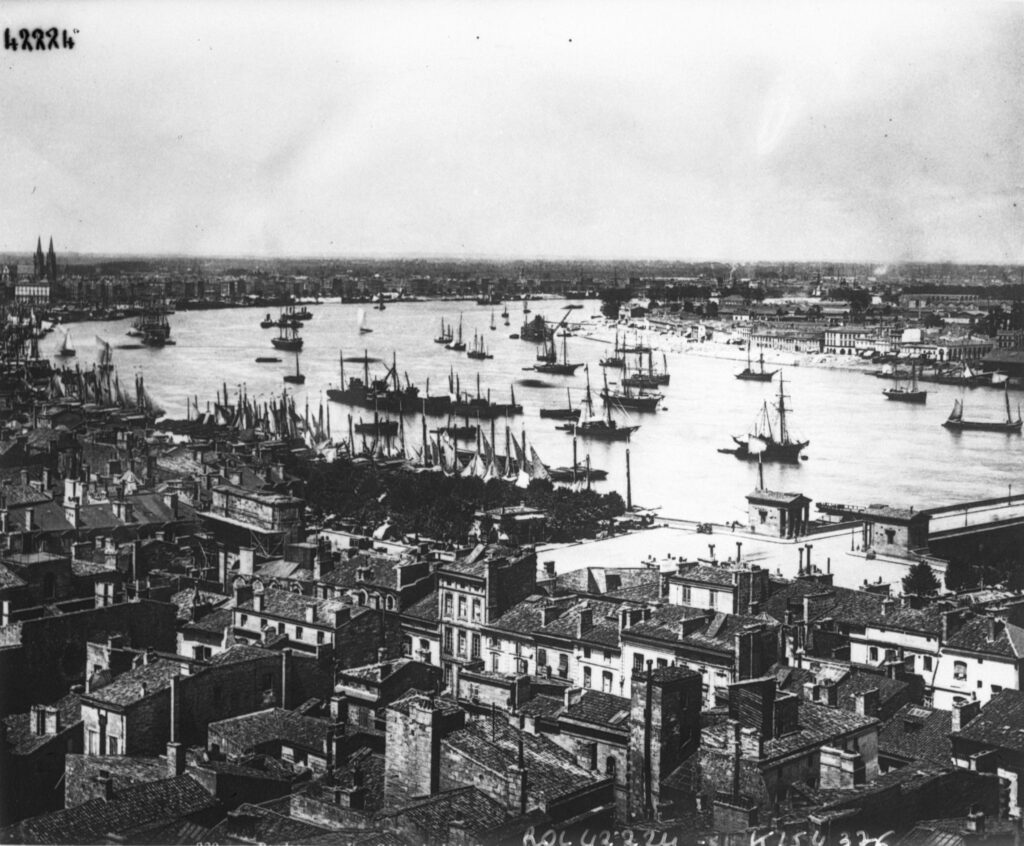
The port has long disappeared but in its place stands the Place de la Bourse and in front of it the Miroir d’Eau, between the Place and the river. The largest water mirror in the world spouts water from the fountains during the day and magically reflects the illuminated, semi circular buildings at night.
If you want to see a superb example of French neoclassical architecture, this is it. The warm stone buildings facing the river in the Place de la Bourse have a wonderful symmetry, fanning out from the centre in two arcs that follow the banks of the river. The Place (Stock Exchange Square) took from 1730 to 1775 to build, replacing the medieval crowded muddle of Bordeaux which was breaking out of the old city walls. The north building was the original stock exchange (now the Chamber of Commerce); the Hôtel des Fermes to the south was built for the local customs authority. It now houses the Musée Nationale des Douanes, reopened in Spring 2025. It’s well worth a visit. We might think that customs and excise is a pretty dull subject, but avoiding taxes has always been an ingenious pastime. A wooden stool opens up to become a salt store. It was designed so the lady of the house could firmly sit on it, hiding the heavily taxed commodity under her voluminous skirts. And such handsome hats.
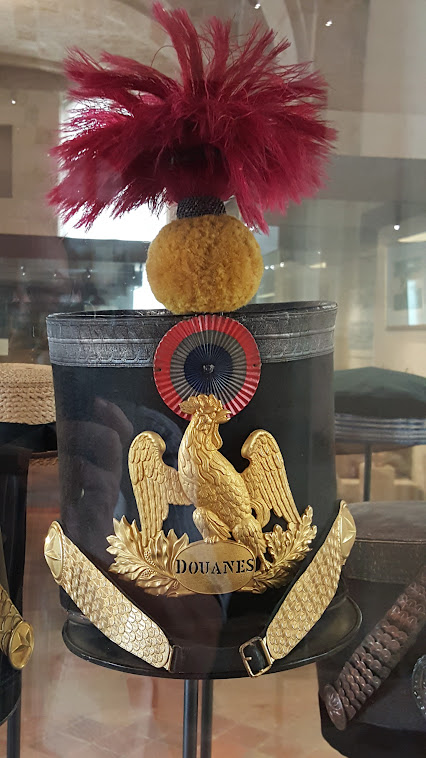
Find out more about the Musée Nationale des Douanes on Mechtraveller.
Les Chartrons

The Chartrons district that housed the wine merchants of the 17th and 18th centuries lies south of the Bacalan. Stone buildings line the streets, the front rooms housing the living quarters of the Lynches, the Bartons, the Johnstons and other English and Irish families who dominated the lucrative trade. At the back lay their large wine warehouses.
It was a bustling, noisy district, housing barrel makers, the glass bottle factory of an Irishman, Pierre Mitchell, which belched out smoke day and night, label printers and heavy carts that transported the barrels to the harbour. According to the excellent Bruno, this was where capitalism was born.
Today it’s a delightful area of antique shops, art galleries, and small boutiques, interrupted by cafés whose pavement tables and chairs are always full. Walk along Rue Notre Dame for its churches, then turn north into the Place du Marché des Chartrons which hosts events and exhibitions. Look out for pretty houses covered in ivy or flowering bushes, that occupy the streets and hidden alleys.
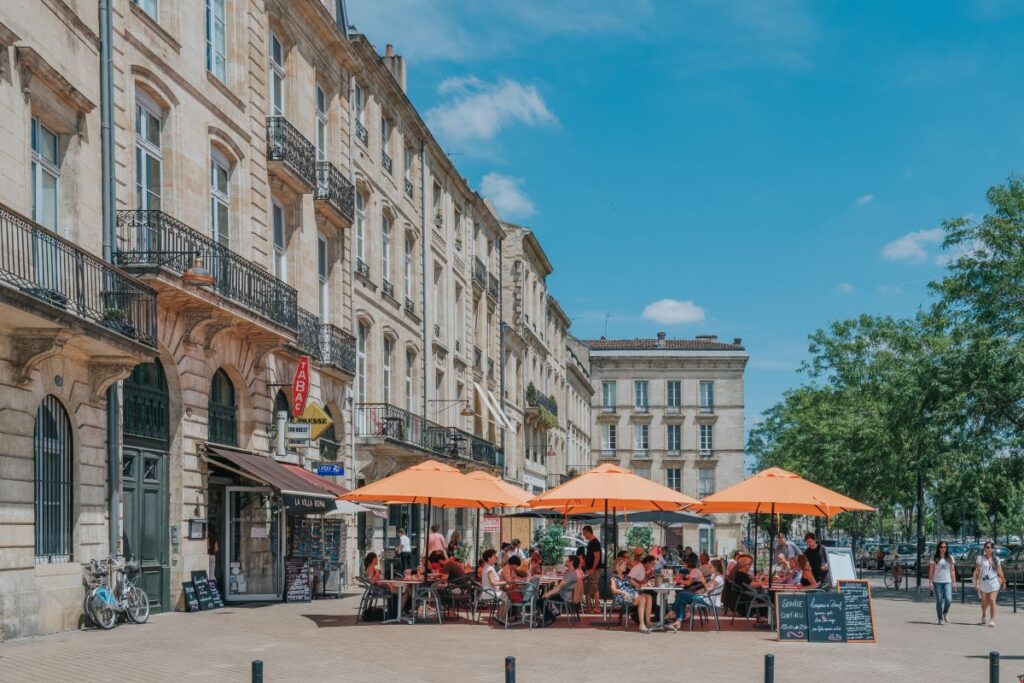
We came across the small but delightful Musée du Vin et du Négoce, housed in one of Bordeaux’s oldest buildings, an Irish merchant’s house of 1720. The crowded museum takes you through vaulted cellars that, with maps, images, models, artefacts, oak barrels and wine bottles, tell the story of the city’s lucrative wine trade in the 18th and 19th centuries, plus the role of the négociant (merchant trader).
America’s First Consulate
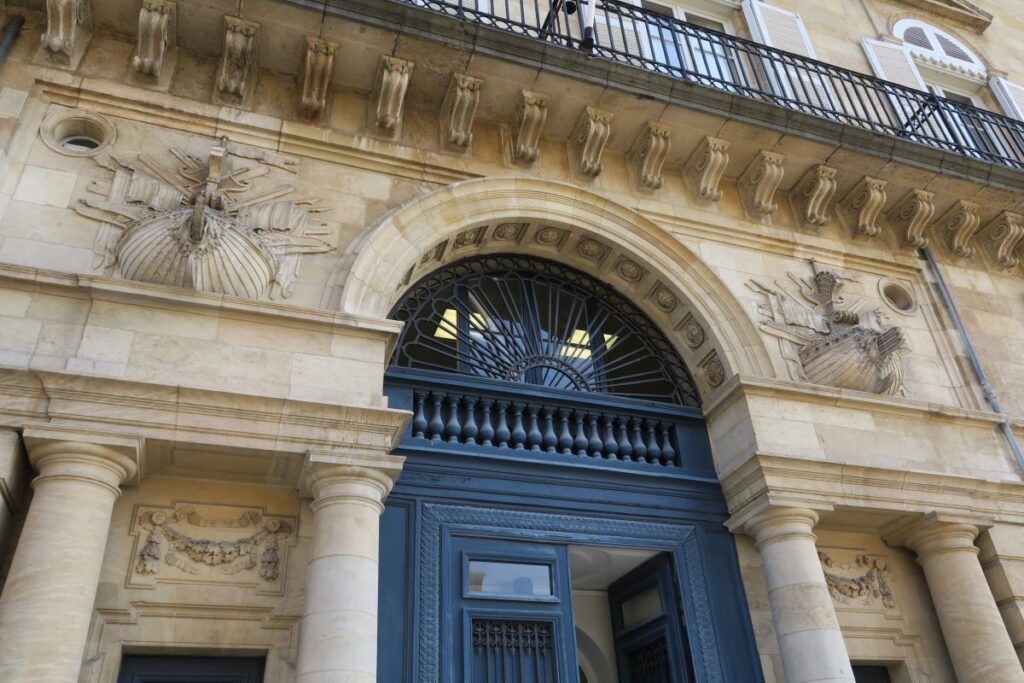
Along the river you’ll come across the old American Consulate, the first such consular post in US history, established in 1778. It’s easy to spot – a plaque commemorates Joseph Fenwick, appointed in 1790. With the French Revolution just starting in the late 18th century, Bordeaux was deemed to be a far safer and more stable city than Paris.
Fenwick’s family had Maryland and South Carolina connections – vital for the US and its trade of Carolina gold rice, sea island cotton and raw indigo dye, shipped from the port of Charleston to Europe.
The Golden Triangle
The Golden Triangle is the centre of Bordeaux, certainly for the Bordelaise, stretching between the Allées de Touray, Cours de l’Intendance and Cours Georges Clemenceau.
This is the area for shopping in the glass Galerie des Grands Hommes, and admiring the grand 18th and 19th century buildings.
The Grand Théâtre de Bordeaux
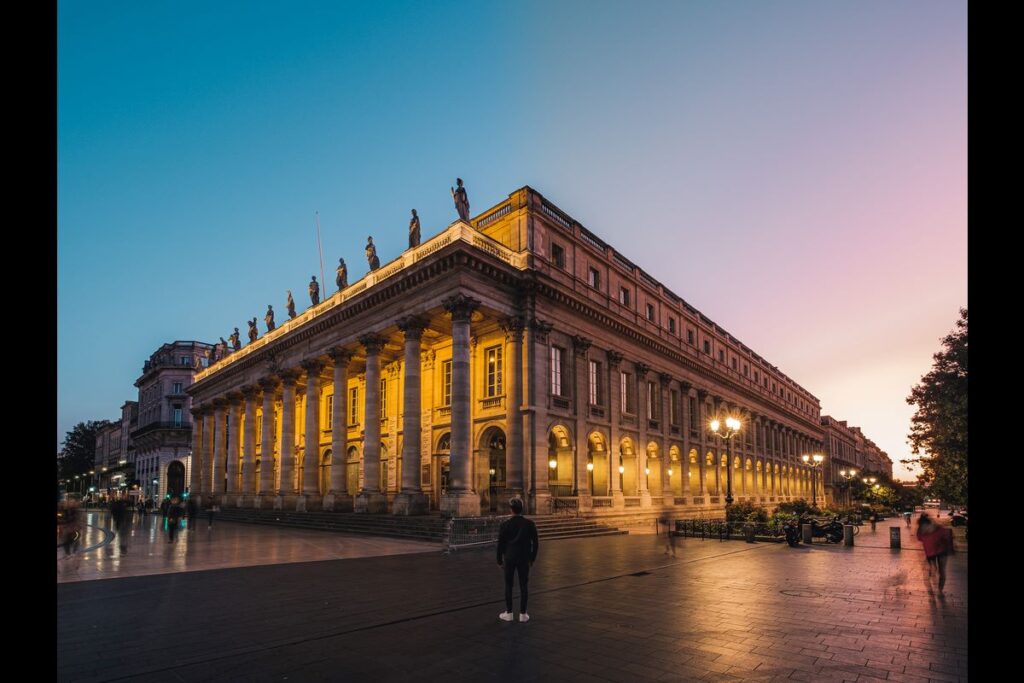
In the heart of the Golden Triangle, this imposing building is a real statement of power. The ‘Temple of the Arts and Light’ was commissioned by Marshal Richelieu (grand-nephew of the famous Cardinal), and designed by the architect Victor Louis, and inaugurated on April 7, 1780. Its distinctive exterior feature is the Corinthian columns running along the façade. Other such buildings have 8 columns; the Bordeaux theatre has 12. Topping the columns 12 statues look out over the city – the nine Muses plus the Roman goddesses Juno, Venus, and Minerva.
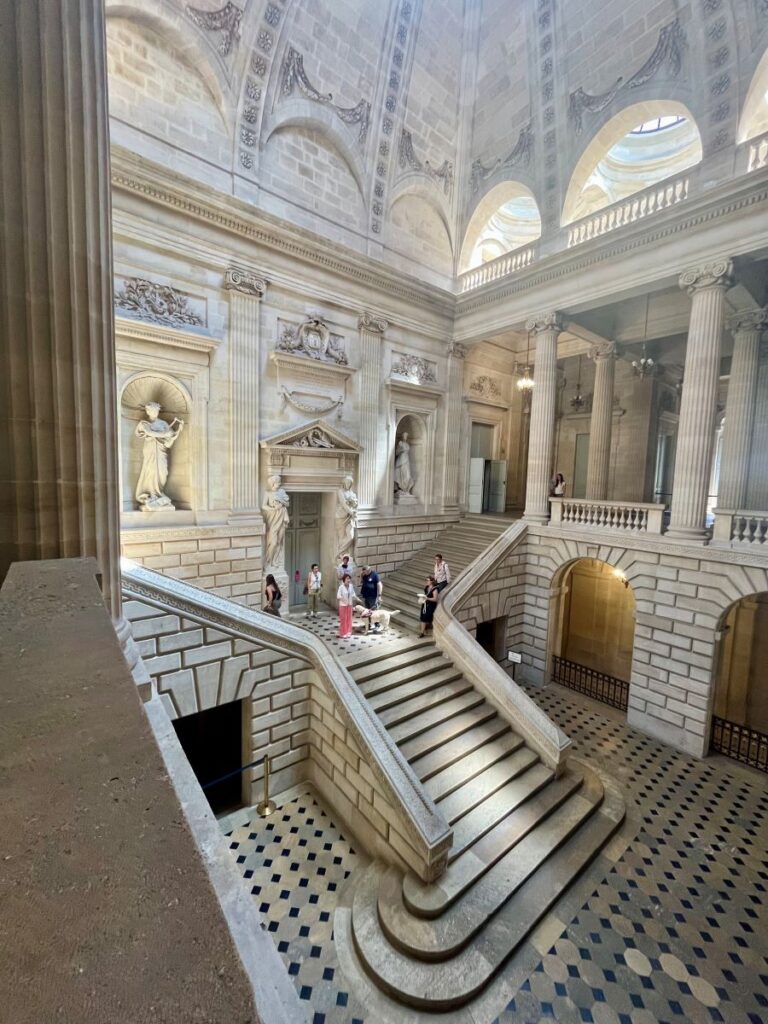
A century later the architect Charles Garnier visited Bordeaux. He was so impressed by the very grand staircase, that he copied the design for his 19th-century grand Paris Opera. You can visit the building and see the staircase. Better still is to get to a performance of the Bordeaux opera or ballet. The acoustics are superb; and for history buffs, the theatre remains one of the oldest wooden framed opera houses still active, having survived fire and rebuilding.
Francisco Goya in Bordeaux
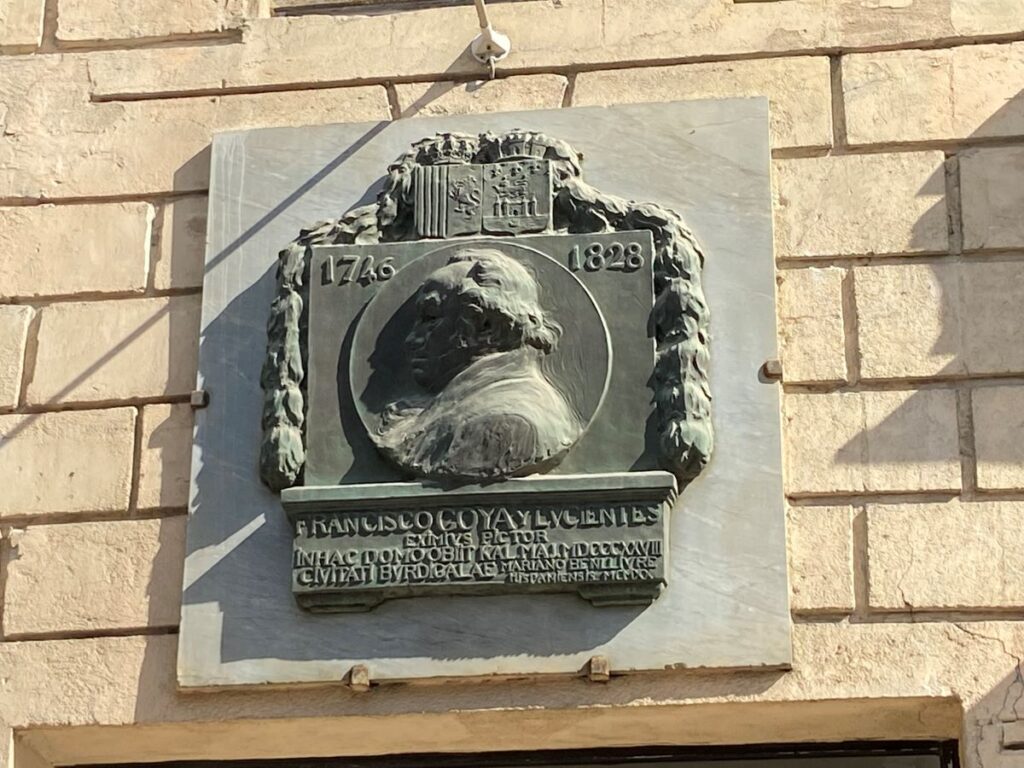
Francisco José de Goya y Lucientes left Spain for Bordeaux in 1824, 78 years old, completely deaf and at odds with the Spanish monarchy. He died in 1828; his funeral was held in the city and he was first buried in Cimetière de la Chartreuse.
A bronze plaque marks his house at 57 Cours de l’Intendance where he lived for the last years of his life. The Spanish connection continues: the building now houses the Institut Cervantes which promotes Spanish language and culture.
In 1888 Goya’s body was exhumed and repatriated to Spain. And here begins the mystery and the stories that Bruno tells with relish. “Goya skeleton without a head,” wrote the Spanish consul in Bordeaux to his Spanish colleague. “Please instruct me.”
Goya’s headless body was taken to the San Antonio de la Florida chapel in Madrid where it now resides under the frescoes in the dome which Goya painted in 1798.
The skull was most possibly acquired by a phrenologist who believed that the secrets of a person’s character lay in the skull. Bruno recounts that it turned up in a local bar and became an object of pilgrimage by the painter’s admirers.
Bordeaux vs Paris
There is (again according to Bruno), a healthy rivalry between these two grand cities of France. Baron Haussmann was a prefect in Bordeaux from 1851 to 1853 and it was here that he first stamped his style. He employed town planners to create grand boulevards leading to spacious squares, transforming the centre. He left Bordeaux to transform Paris. And once the architectural similarities are pointed out, you see the evidence everywhere.
Place des Quinconces
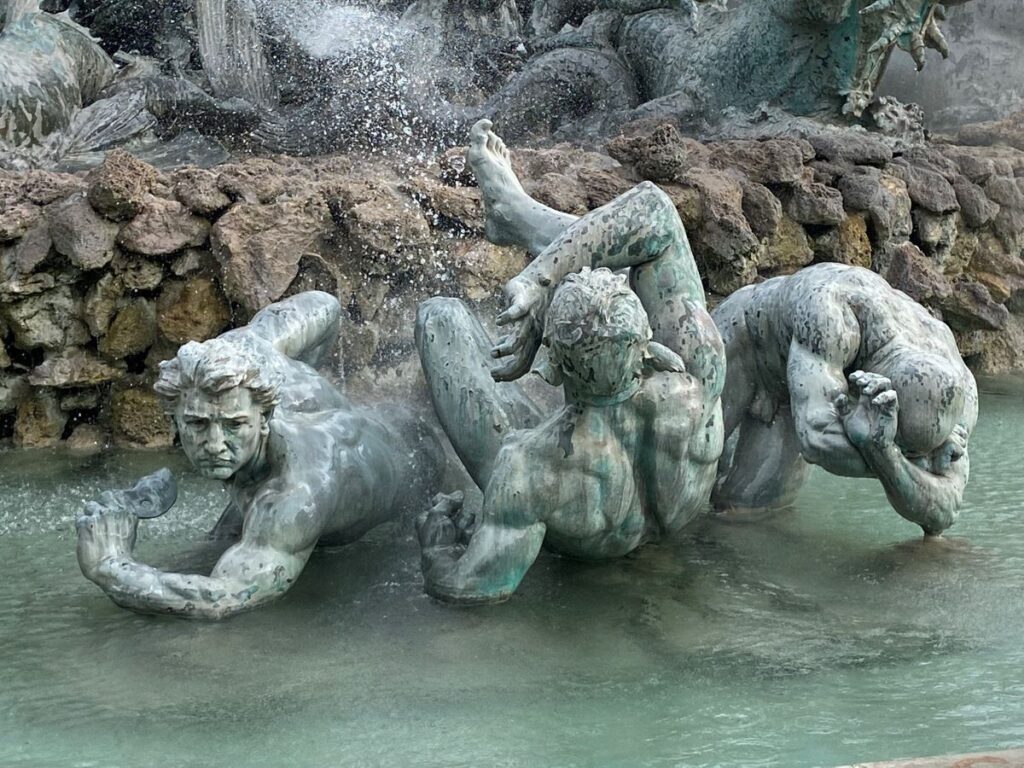
The Place des Quinconces is one of the largest squares in France, today the location for big fairs (the brocante fair in late April/early May is one of the best in France. At one end stands the Monument aux Girondins, a giant column commemorating the victims of the Terror during the French Revolution. It’s topped with a statue of Liberty Breaking her Chains.
Also unmissable is the extraordinary fountain, with its bronze horses pulling chariots and allegorical figures that represent liberty, justice and the Dordogne and Garonne.
The Garonne River
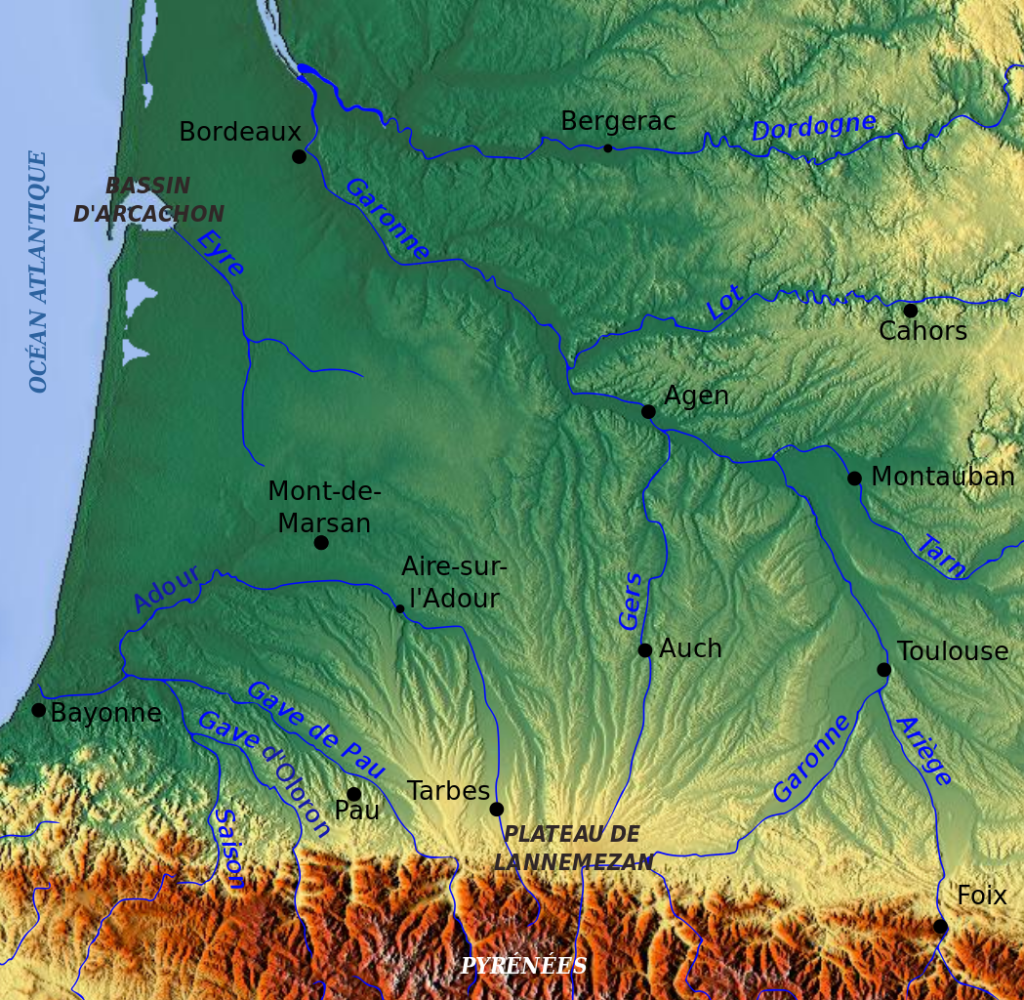
Bordeaux is the major port on the mighty Garonne River and marks the point where the river flows into the Gironde estuary and from there into the Bay of Biscay. The city sits between the two major wine-producing areas of Entre-deux-Mers to the east and Médoc to the west.
For centuries it marked the division between the rich on the left bank and the poor opposite. Today, as the city expands, the right bank is developing fast and has become the trendy alternative place to live, work and play.
Crossing the River to the Right Bank
We took the Bat ferry , which runs along the Garonne from the Pont de Pierre to Lormont with stops at Stalingrad, Quinconces, Hangars Médoc, and Cité du Vin. It’s as good as a mini cruise (very mini; it just takes 25 to 35 minutes to travel between its endpoints along the 25-kilometer route). It costs the same as tickets used on buses and trams. 1 trip: €1.70; 2 trips: €3.00; 10 trips: €13.70.
Check the website for detailed information.
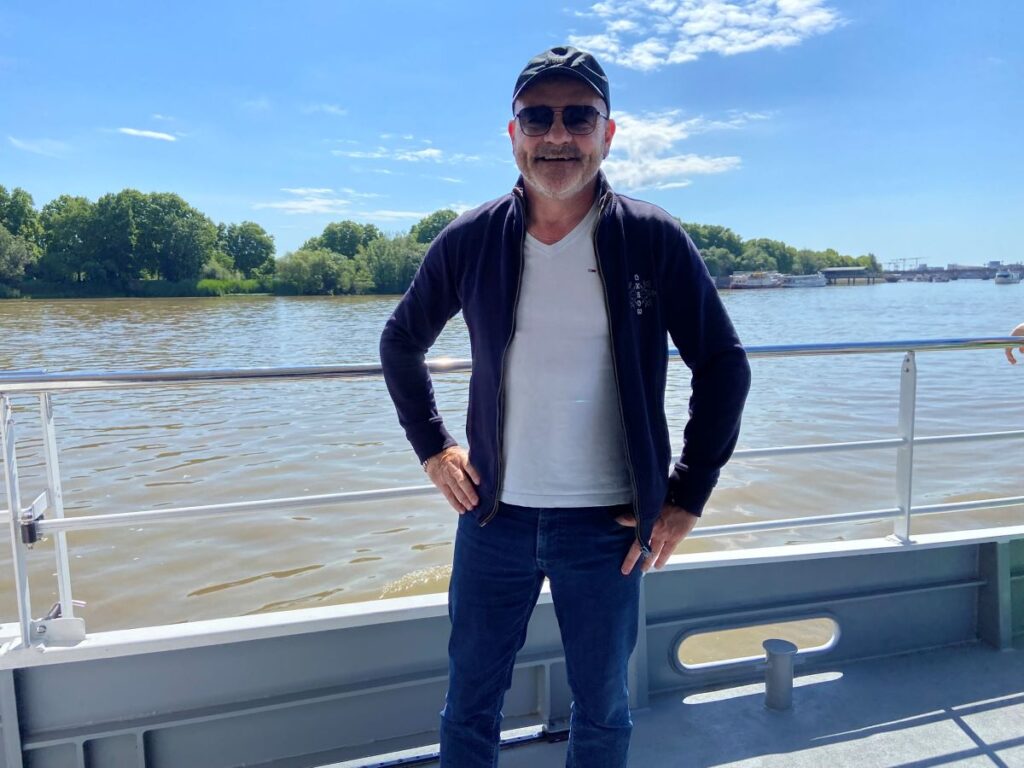
Darwin ecosystem
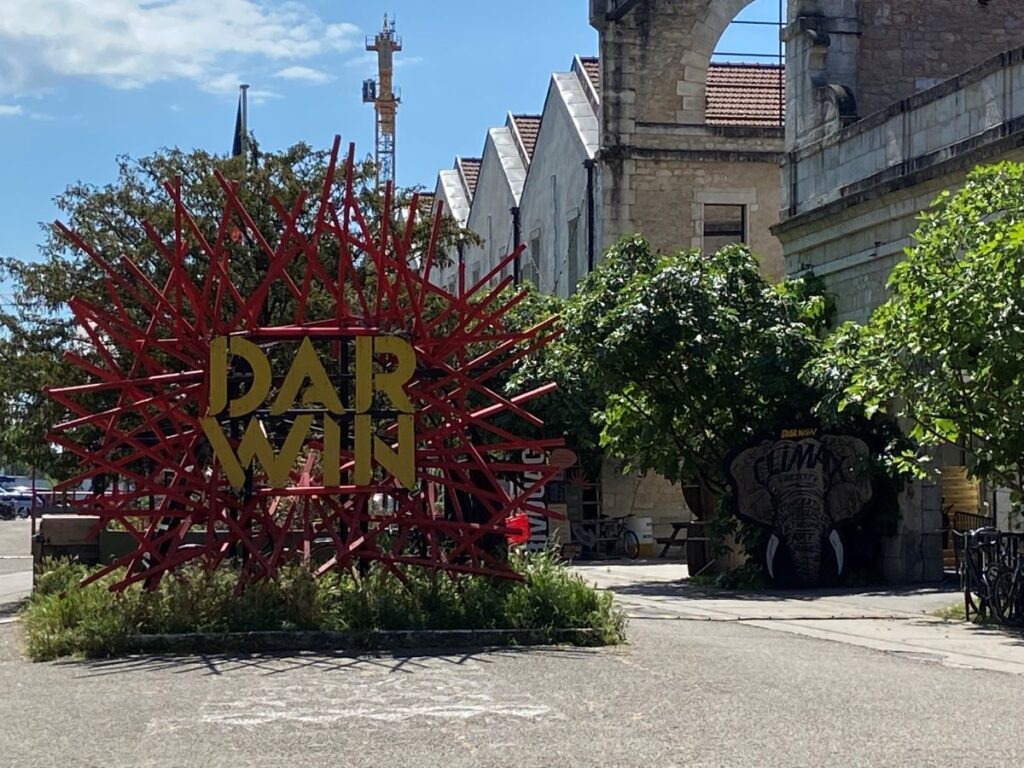
Darwin ecosystem, housed in a former barracks, takes up much of the right bank. It’s a large area with restaurants, bars and cafés, a skatepark and a handful of very cool shops. Veja cleans, repairs and recycles its old shoes; go to Shop Sauvages for clothes which you have to be seen in (if aspiring to be casually chic); librairie La Géolibri sells books, posters and more, and Bric à Brac Emmaüs is the place for recycled items.
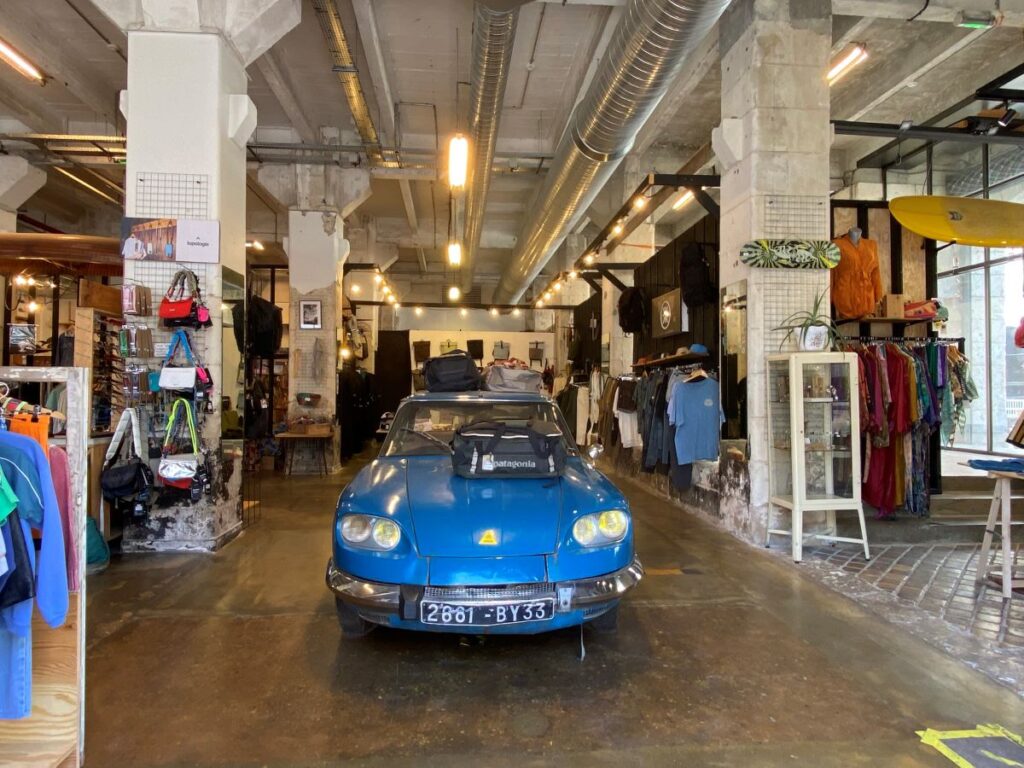
There are events and street performances all year round, so keep an eye on the Darwin website for up-to-date information.
And of course there are plenty of places to eat, many of them offering organic ingredients. We had lunch at la Belle Saison, sitting outside and looking over to the left bank. Good value, excellent service and delicious food.
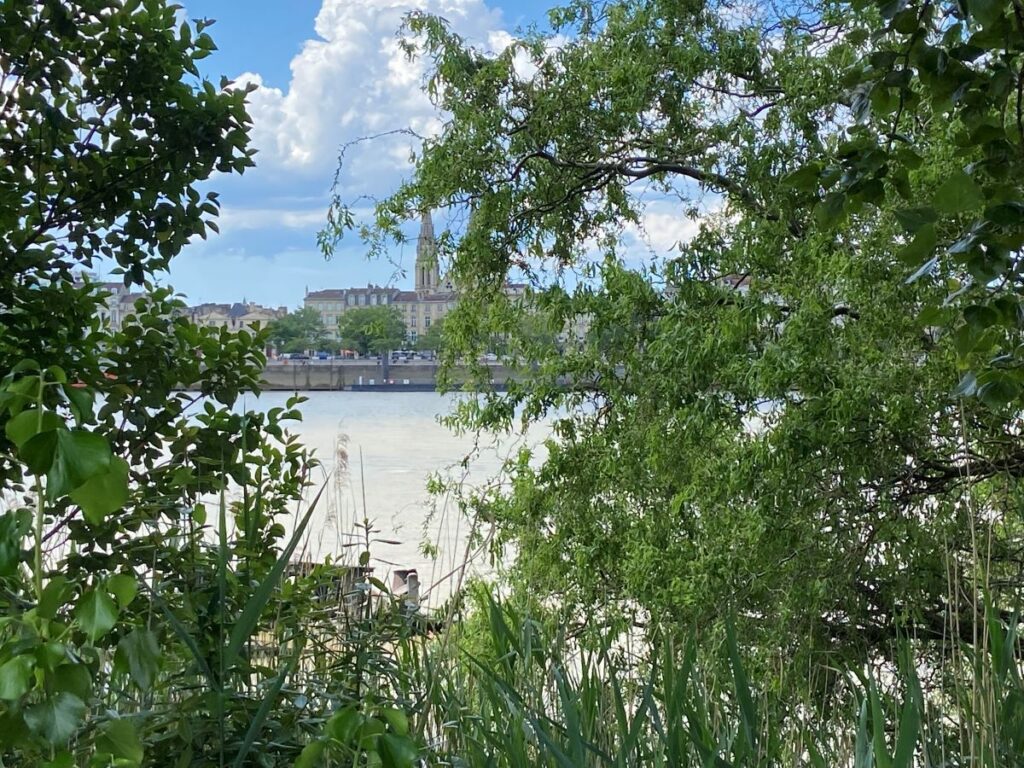
Tip: Try to avoid Mondays when many shops are closed.
Bordeaux UNESCO World Heritage Site
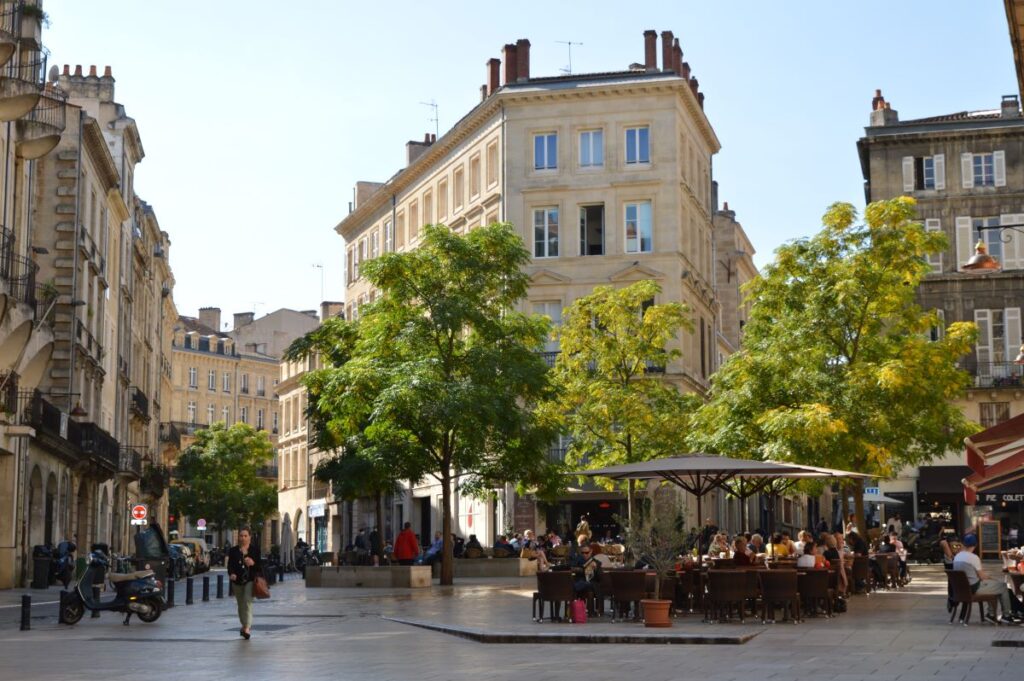
In 2007 Bordeaux, The Port of the Moon, was given the world’s highest award for the unity of its exceptional urban heritage. Created in the 18th-century age of the Enlightenment, Bordeaux has more than 350 listed Historical Monuments. Most striking is the sheer size of the UNESCO perimeter: 1,810 hectares in total, amounting to almost half of the city’s surface area. In total Bordeaux has more protected buildings than any city after Paris.
UNESCO also recognised the history role Bordeaux has played as a city enjoying an exchange of cultural values for over 2,000 years…particularly highlighting the commercial links with Britain and the Low Lands (Holland and Belgium) from the 12th century.
Bordeaux and Britain
In 1152 Eleanor of Aquitaine married Henry Plantagenet bringing Bordeaux under English rule. For Bordeaux it was significant, heralding the start of the dominant trade of Bordeaux wine to England, helped by the special privileges that Henry offered. With 25% of the total Bordeaux output going to England, ‘claret’ (as Bordeaux red wine was called) became a staple and has remained a favorite ever since.
For more about the Plantagenets and the English connection, visit…Le Mans! It comes as a surprise (and it certainly did to me) but Le Mans has one of the largest medieval preserved quarters in France.
Where We Stayed in Bordeaux
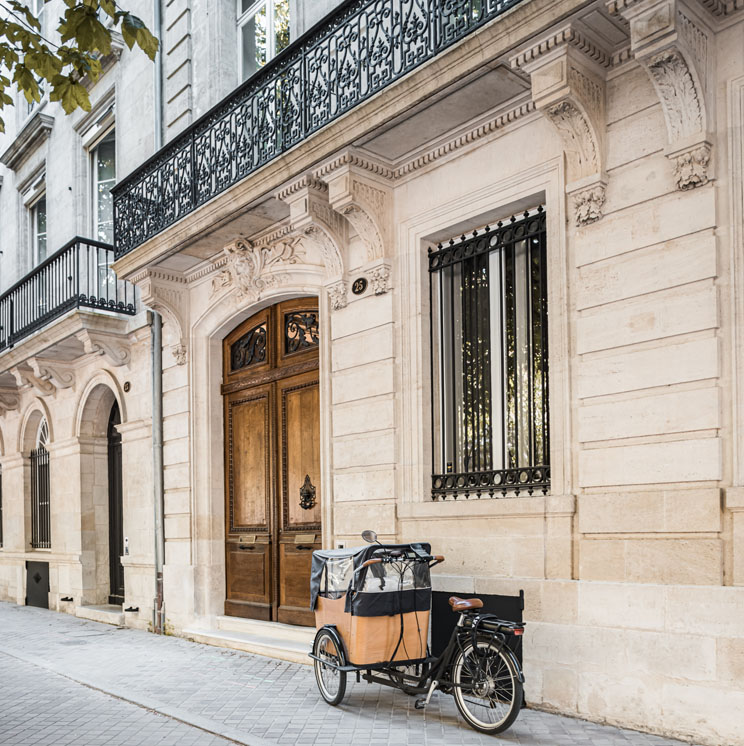
We stayed at Villas Foch, a 5-star privately owned boutique hotel with just 12 rooms and eight suites. Housed in two adjoining 19th-century classical stone buildings, it’s been beautifully restored and has quirky modern touches, like the spectacular chandelier that hangs in one of the grand staircases.
There’s a cosy Le Ferdinand bar, a spa and pool and a great breakfast room. Bedrooms are light and airy with impeccable bathrooms. A portrait of Foch in each room follows you around, which I found rather companionable. Villas Foch is just a few minutes from the Place des Quinconces, so it’s pretty central but feels tucked away. Rooms from €550.
Villas Foch
25 cours du Maréchal Foch
33000 Bordeaux
Tel:+33 (0)5 64 31 22 50
Website
Restaurants in Bordeaux
Bordeaux is one of France’s great culinary cities, up there with Paris and Lyon. You’ll find restaurants for every budget and style, but here’s a small selection of ones I have enjoyed.
Le 1925 Brasserie
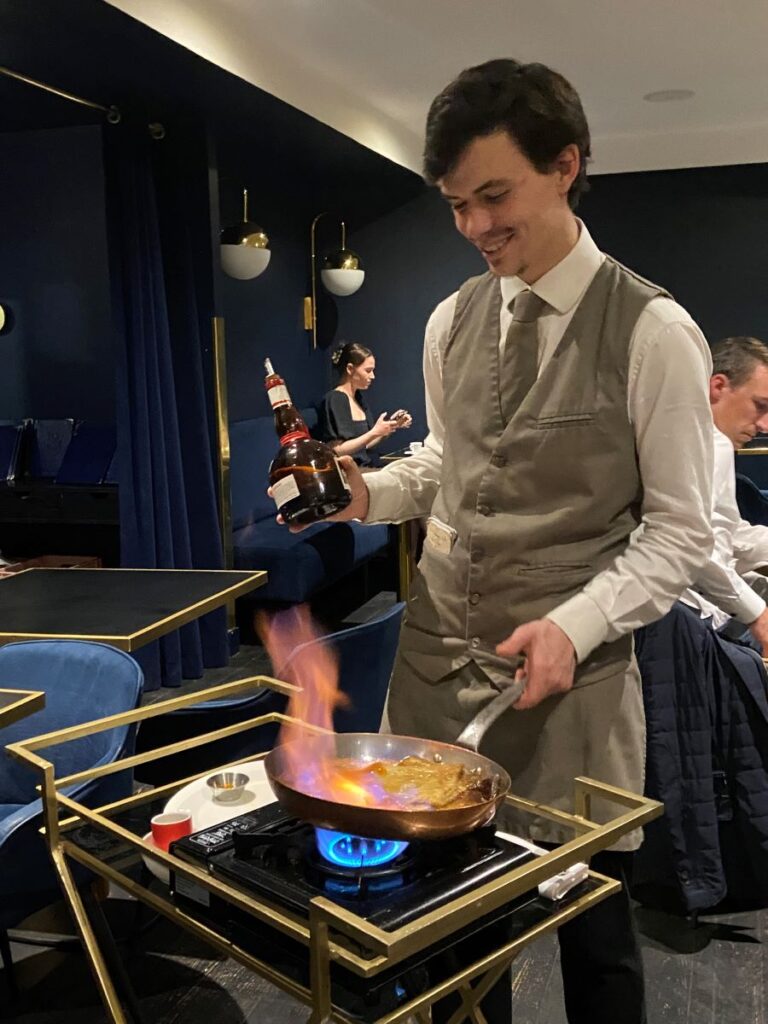
Come to Le 1925 Brasserie as much for the brasserie style as the cooking which is classically based: pig’s trotter, snails, oysters and some of the best heritage tomatoes I’ve come across for starters. Mains range from prawn risotto to duck breast, beef tartare or pork confit shoulder, all served with extra favourites like French fries, home-made mash, green salad. And desserts? Chocolate mousse, sorbets or…where else can you find this these days? Crêpes Suzette flambé Grand Marnier which is prepared dramatically at your table. And the wine list is superb, selected by the owner who invariably will appear to chat to his customers.
Starters from €10 to €28; mains €25 to €35; desserts €10 to €15 (for that flaming fabulous crêpes Suzette)
Le 1925 Brasserie
4 Place des Quinconces
Tel: +33 (0)5 56 52 84 56
Website
Le 7
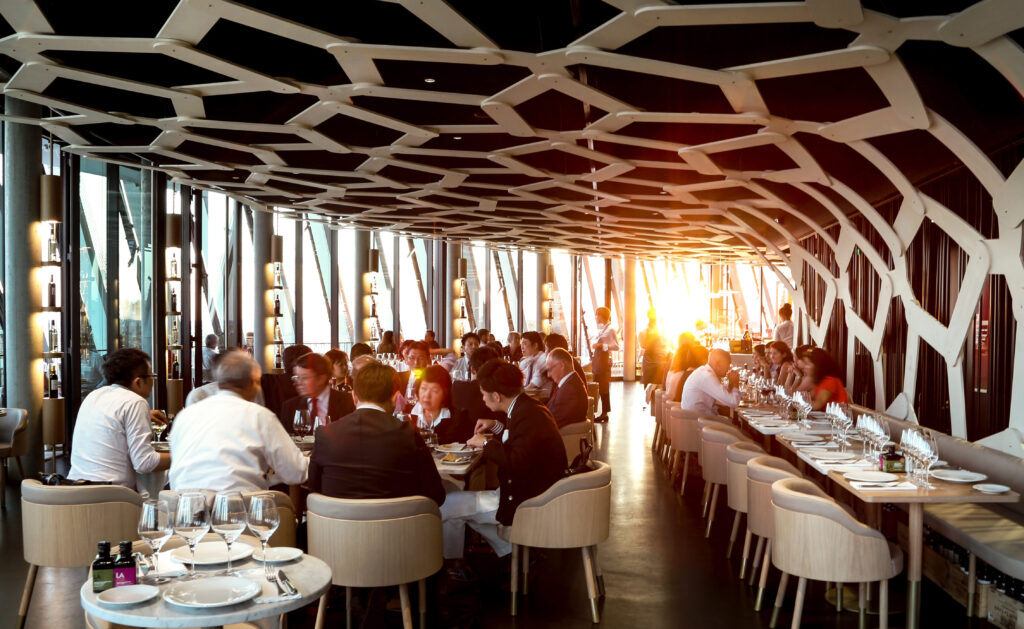
At the top of the Cité du Vin on the 7th floor, the restaurant offers spectacular views over the port and beyond along with top regional cooking. Creamy burrata with sautéed artichoke, piquilio pepper sauce and basil oil was followed by slow-cooked chicken supreme then an After Eight dessert (go there to discover this one). And of course, a great wine list of 500 wines from 50 countries, with a selection of 32 wines by the glass.
Starters from €21 to €25; mains from €31 to €37; desserts from €10 to €16.
Mon-Fri lunch menu starter and main €32; 5 course dinner menu €70; childrens menu 3 courses €16 (free on Wednesday except school holidays).
Le 7
Cité du Vin
Esplanade de Pontac
Tel: +33 (0)5 64 31 05 40
Website
Le Chapon Fin
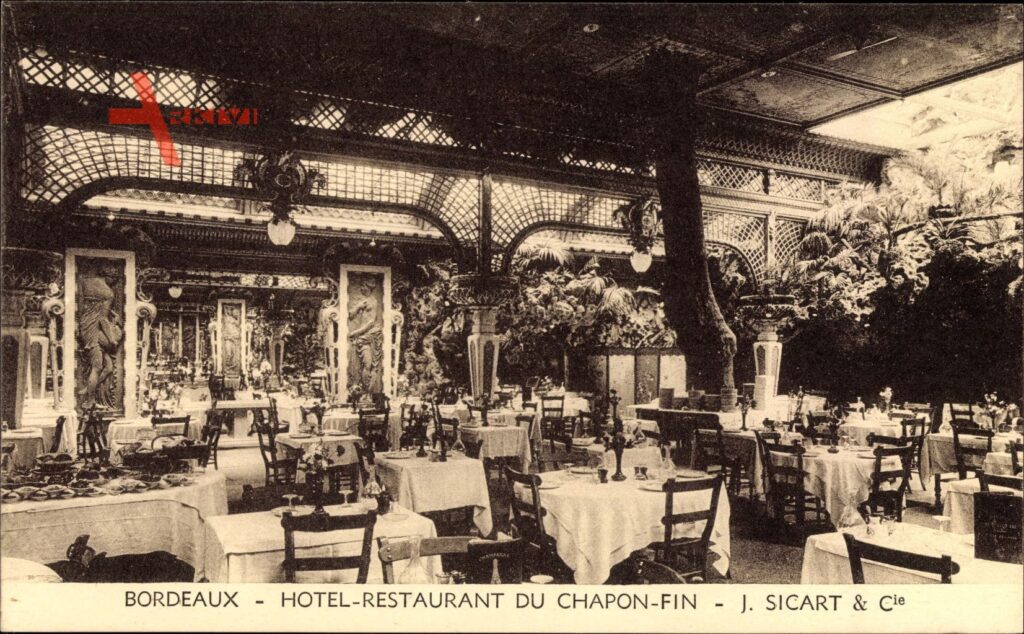
The word ‘historic’ is often over-used. But Le Chapon Fin is a restaurant that can rightly claim the description.
Le Chapon Fin opened in 1825 when much of central Bordeaux was being rebuilt in the classical style by Haussmann. In 1900 Le Chapon Fin was renovated. Perhaps renovation isn’t not the right word; an adventurous owner and equally adventurous architect brought the outside in with a rocky scene at the and a lot of plants.
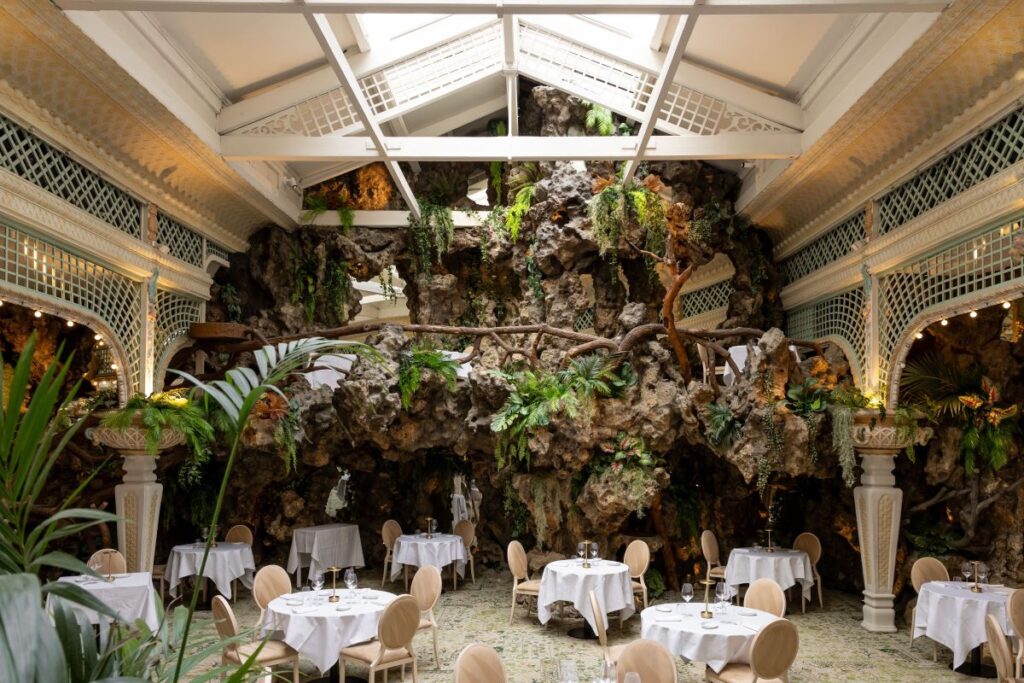
The restaurant became the place to go. The Spanish King Alphonse XIII kept a private cellar here; diners included the Sultan of Morocco, the Prince of Wales (Edward VII) and artists like Sarah Bernhardt and Toulouse Lautrec as well as George Clemenceau and a host of politicians.
Today its reputation, particularly for its wines, is in the capable hands of owner Sylvie Cazes who comes from a family of wine makers. She was very much involved in the Cité du Vin, and jointly owns the famous Château Lynch-Bages and Château Chauvin vineyards, and the company Bordeaux Saveurs which tailor makes visits to vineyards.
This is not a restaurant to go to on a casual basis; the cooking, based on the south west, includes dishes like field and garden tomatoes with various different oils, followed by chicken breast, crispy breadcrumbs and roasted broccoli. Or be more ambitious and taste a bit of history with Alphonse XIII pigeon with tobacco leaf, corn and vanilla.
Menu Marché: from 35€ to 45 €. Or make it a special occasion with the historic menu whose dishes are inspired by significant dates from 1825 to 2024. €78 to €98 .
Le Chapon Fin
5 rue Montesquieu
Tel: +33 05 56 79 10 10
Website
Getting to Bordeaux
From Paris by train: The TGV is direct and takes 2 hours from Paris.
From the UK: By plane: BA, Easyjet and AirFrance fly from London and regional cities to Bordeaux.
Take the tram from the airport to city centre
Getting around Bordeaux
The city centre is very walkable with pedestrian areas throughout. The tram system runs throughout Bordeaux, using a unique ground power system so you’re not distracted by overhead wires. It runs from 5am to midnight or 1 a.m. depending on the day. There are regular buses.
Bordeaux Tourism website
Bordeaux Tourist Office
The Bordeaux Tourist Office can help with all your queries, from hotel bookings to guided tours.
12 cours du XXX juillet
33080 Bordeaux
+33 (0)5 56 00 66 00
Website
Open Monday to Saturday 9am to 6pm; Sunday and public holidays 10am-5pm
More about the Bordeaux Region
The French Atlantic Coast
The Glorious Vendée Department
AND...
Great Rivers of France

